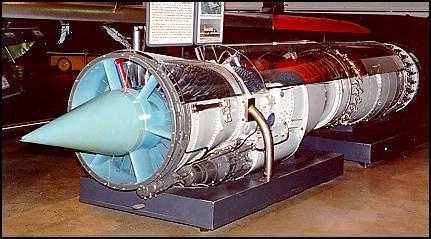Pratt & Whitney J-57 Turbojet
 The J57 production engine was the world's first jet engine to develop
10,000 lbs. thrust. It evolved from the T45 turboprop engine designed for the XB-52
program. As advances in the B-52 design dictated greater power requirements, the turboprop
concept was discarded and the wasp-waisted J57 turbojet was developed. The J57 featured a
dual-rotor axial-flow compressor which allowed low fuel consumption over a wide operating
range and improved the sluggish acceleration previously characteristic of jet engines.
The J57 production engine was the world's first jet engine to develop
10,000 lbs. thrust. It evolved from the T45 turboprop engine designed for the XB-52
program. As advances in the B-52 design dictated greater power requirements, the turboprop
concept was discarded and the wasp-waisted J57 turbojet was developed. The J57 featured a
dual-rotor axial-flow compressor which allowed low fuel consumption over a wide operating
range and improved the sluggish acceleration previously characteristic of jet engines.
The same year that production began, 1953, America's
highest aviation honor, the Collier Trophy, was awarded for the design and development of
this engine. Using a J57, the North American YF-100A
became the world's first fighter aircraft to reach supersonic speed in level flight, on
its maiden flight on May 25, 1953. Later versions of the J57 and its commercial
equivalent, the JT3, reached the 18,000 lbs. thrust level with an afterburner. When
production ended in 1970, more than 21,000 of these engines had been built. In addition to
the B-52 and F-100, the J57 (or JT3) powered the Vought F8U;
Douglas F4D, F5D, and A3D; Boeing 707 and 720; Douglas DC-8; and numerous USAF aircraft
including the KC-135, F-101A, and F-102A.
The J57 on display is a YJ57-P-3, the first series to
go into production. Rated at 8,700 lbs. thrust, it served as the prototype for the
higher-powered engines later used in B-52s. P-3s were also used in testing the Northrop
XSM-62 Snark missile and the Convair XB-60, an all-jet development of the B-36. This
engine was the 16th of the 95 P-3s built and was used in XB-52 testing.
- First flight: 1951
- Production years: 1951-1965
- Engines produced: 21,170
Courtesy U.S. Air Force Museum & United Technologies Corp. - Pratt & Whitney
U.S.Fighter
Home | Feedback <BGSOUND SRC="http://audio/topgun2.wav"loop=1>
 The J57 production engine was the world's first jet engine to develop
10,000 lbs. thrust. It evolved from the T45 turboprop engine designed for the XB-52
program. As advances in the B-52 design dictated greater power requirements, the turboprop
concept was discarded and the wasp-waisted J57 turbojet was developed. The J57 featured a
dual-rotor axial-flow compressor which allowed low fuel consumption over a wide operating
range and improved the sluggish acceleration previously characteristic of jet engines.
The J57 production engine was the world's first jet engine to develop
10,000 lbs. thrust. It evolved from the T45 turboprop engine designed for the XB-52
program. As advances in the B-52 design dictated greater power requirements, the turboprop
concept was discarded and the wasp-waisted J57 turbojet was developed. The J57 featured a
dual-rotor axial-flow compressor which allowed low fuel consumption over a wide operating
range and improved the sluggish acceleration previously characteristic of jet engines.